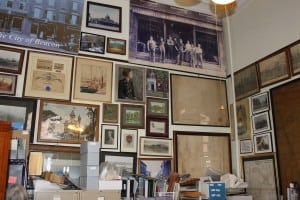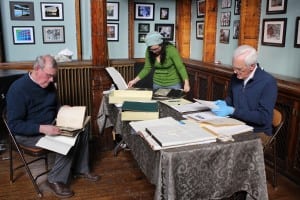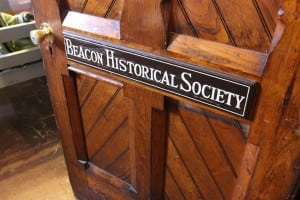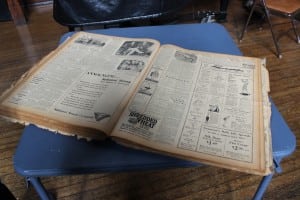Society turns 40 but needs space
By Alison Rooney
Feeling a bit steeped in history itself, the Beacon Historical Society (BHS) is celebrating its 40th anniversary. Formed in 1976 by a small group of people dedicated to preserving and documenting Beacon’s history from pre-Colonial times to the present, the all-volunteer organization has long been housed in a packed-to-the-gills room inside the Howland Cultural Center. There it’s pull-open-a-drawer, discover-a-treasure-time as the tight quarters hold centuries’ worth of maps, papers, photographs, postcards, objects, clothing and more — even a church pew and a bench from the old ferry, both used for seating today.
The BHS has been in residence at the Howland Center for 20-odd years, after beginning its life at Howland Library. Open twice weekly to the public for research inquiries, the BHS is a busy place. Many visitors are home and business owners wondering about the provenance of the place they’ve purchased, while others are writers or researchers, seeking to get the details right or ferreting out information pertaining to any number of topics — immigration, textile manufacturing, transportation among them. There are nascent institutions too: Dia:Beacon’s planners came in when the museum purchased the former Nabisco site, as did the restorers of the Beacon Institute’s Dennings Point Rivers and Estuaries complex.

Inside the room, your eye can’t help following the vines of history on the walls: a large photo of workers outside of A.C. Smith & Co., landscapes, property-line drawings, a painting by famed Beacon artist Alice Judson. Turn around and there’s signage: wooden placards from the old Newburgh-Beacon Ferry, a shingle hung by Dr. Phebe V.V. Doughty. There’s even a wooden grave marker, that of a child who died in his sleep. It was found, noted longtime BHS volunteer Mary Colbert, in a Beacon basement — turns out that such markers were common but didn’t usually last.
Such donations come in nearly every week; it falls to a cohort of 10 to 12 regular volunteers to document, maintain, store and retrieve them for interested parties. The policy standard is that everything in the collection must be related to Beacon; ownership must be ascertainable; and size is a factor — the society doesn’t have room for large pieces of furniture. Donors are provided with a deed of gift. Unusual items come through the portal as well: upscale rubber toys manufactured by Beacon’s Toycrofters in the 1920s, and hats, of course, and hat molds. Carriages made by Jackson’s, even bricks manufactured by one of many Beacon factories, each embossing its own symbol. And there is the ephemera: trolley schedules; Beacon Incline Railway tickets; school notebooks; uniform buttons; operating records from Highland Hospital; along with more “official” documents such as a 1769 Rombout Precinct Tax List and copies of Civil War pension records, all preserved as best as possible, some in archival folders and boxes, others, simply, for the time being, in file folders.

Some of the most precious material can’t be easily categorized: during World War I, the pastor of St. Luke’s wrote to soldiers on the front. His letters have not been found, but the soldiers’ replies, “upbeat, with very neat handwriting,” according to Colbert, have been collected. Also on hand are bound editions of the Beacon News, annual city directories and the Sanborn Maps, which were drawn for insurance purposes and on which one can spot the changes over the years — all inviting a browse (gloves provided, to protect the documents). Little of it has been digitalized, there isn’t the money at the moment.
The wealth of information on hand isn’t limited to the tangible. Questions arise, and the BHS volunteers try their best to find answers. They’re not always cut and dry. Myths, legends and family lore loom, frequently relating to what might or might not have “been” on the mountain.
While no appointment is required, Colbert says it is helpful to check in before turning up, especially with specialized requests relying on the detective work of BHS President Bob Murphy, whose “knowledge is extensive and beyond the reach of the rest of us,” Colbert says, to make sure he will be there on the day.

The BHS has an array of wishes and goals. High on the list is an oral history project to record the memories of older residents. “There are a lot of people in the city of Beacon who have a lot of information we really need to capture, and many of them are housebound or at nursing homes,” Colbert says. “It would be a great project for a high school.”
Then there are the cramped quarters. BHS aspires to have a home large enough to present exhibits, for additional archival storage space, for researchers, for viewing video and films. To make that happen, BHS says it needs additional volunteers, particularly in the areas of grant writing and fundraising. Some of the work must be done from home because of space constraints — there is frequently an overflow in the room. Volunteering can be seductive, Colbert shares. “The first time I came in here I said, ‘Holy moly, this is a treasure trove,’” she says. “And then I never left.”

As part of its outreach, BHS produces a monthly newsletter and cultivates a membership program with different levels: basic, business and student. It meets at 7 p.m. every fourth Thursday except in January and February, with slide presentations on local history. It also holds community meetings several times a year. At the most recent gathering in October, about 40 attendees explored ideas and pathways to finding a new home for the collection. Several volunteers plan to report back at a community meeting scheduled for 7 p.m. on Tuesday, Jan. 26.
The BHS is located at the Howland Center, 477 Main St. Its hours are 10 a.m. to noon on Thursdays and 1 to 3 p.m. on Saturdays. For more information, visit beaconhistorical.org or its Facebook page.
